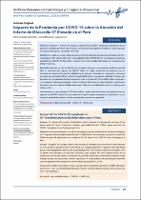| dc.contributor.author | Custodio Sánchez, Piero | |
| dc.contributor.author | Miranda, David | |
| dc.contributor.author | Murillo, Luis | |
| dc.date.accessioned | 2021-10-03T23:12:49Z | |
| dc.date.available | 2021-10-03T23:12:49Z | |
| dc.date.issued | 2020-07-09 | |
| dc.identifier.citation | Archivos Peruanos de Cardiología y Cirugía Cardiovascular. 2020; 1(2). | es_PE |
| dc.identifier.issn | 2708-7212 | |
| dc.identifier.uri | https://hdl.handle.net/20.500.12959/1929 | |
| dc.description.abstract | Objetivo: Comparar el número de ingresos, características clínicas y resultados terapéuticos de los pacientes atendidos por infarto de miocardio con elevación del segmento ST (IMCEST) antes y durante el estado de emergencia por COVID-19 en Perú.
Métodos: Se realizó un estudio descriptivo y comparativo de cohortes, derivadas del PEruvian Registry of ST-segment Elevation Myocardial Infarction II (PERSTEMI II). Se comparó los pacientes atendidos por IMCEST 45 días antes y durante los 45 días iniciales del estado de emergencia por COVID-19 en Perú.
Resultados: Durante los primeros 45 días del período de emergencia se encontró una disminución del 59% en el número de ingresos por IMCEST. Hubo una mayor proporción de pacientes con antecedentes de hipertensión arterial y dislipidemia. Se observó una tendencia a reducción en el acceso a terapias de reperfusión (73.5% vs 66.6%), siendo la fibrinólisis la terapia más utilizada. El motivo más frecuente de no reperfusión fue la presentación tardía >24 horas (41.7%, p=0.004). Hubo una tendencia a reducción del tiempo al primer contacto médico y del tiempo de isquemia hasta la reperfusión. Se registró menor incidencia de falla cardíaca post infarto. La mortalidad fue similar en ambos grupos (3.4% vs 2.7%).
Conclusiones: La pandemia por COVID-19 en el Perú ha generado una disminución significativa en los ingresos por IMCEST, además de una tendencia a menor empleo de terapias de reperfusión. La presentación tardía de los pacientes fue la causa más frecuente de no reperfusión. | es_PE |
| dc.description.abstract | Purpose: To compare the number of admissions, clinical features and therapeutic outcomes of patients treated for acute ST-segment elevation myocardial infarction (STEMI), before and after the
COVID-19 pandemic state of emergency in Peru.
Methods: Observational analytical study of retrospective cohorts, derivated from the PEruvian Registry
of ST-segment Elevation Myocardial Infarction II (PERSTEMI II). We compared the patients treated for
STEMI, between 45 days before and during the first 45 days of the COVID-19 state of emergency in
Peru.
Results: During the first 45 days of the COVID-19 state of emergency, the team found a 59% decrease
on the number of admissions for STEMI. There was a larger proportion of patients with high blood
pressure and dyslipidemia. We noticed a decreasing trend in the access to reperfusion therapies (73%
vs. 66.6%); the fibrinolysis was the most commonly used therapy. The most frequent reason for no
reperfusion was the late onset >24 hours (41.7%, p=0.004). There was a trend of time reduction to first
medical contact and less ischemia time to reperfusion. A lower incidence of post-infarction heart failure was registered. The mortality was similar in both groups (3.4% vs. 2.7%).
Conclusions: COVID-19 pandemic in Peru has generated a significant reduction of STEMI admissions
and a trend in less use of reperfusion therapies. The late onset of patients was the most common reason of not reperfusion. | |
| dc.format | application/pdf | es_PE |
| dc.language.iso | spa | es_PE |
| dc.publisher | Seguro Social de Salud (EsSalud) | es_PE |
| dc.relation.uri | https://apcyccv.org.pe/index.php/apccc/article/view/22 | |
| dc.rights | info:eu-repo/semantics/openAccess | es_PE |
| dc.rights.uri | https://creativecommons.org/licenses/by/4.0/ | es_PE |
| dc.subject | Infarto de miocardio | es_PE |
| dc.subject | Covid-19 | es_PE |
| dc.subject | SARS-CoV2 | es_PE |
| dc.subject | Pandemia | es_PE |
| dc.subject | Perú | es_PE |
| dc.subject | Myocardial infarction | |
| dc.title | Impacto de la pandemia por COVID-19 sobre la atención del infarto de miocardio ST elevado en el Perú | es_PE |
| dc.title.alternative | Impact of the COVID-19 pandemic on ST- elevation myocardial infarction care in Peru | |
| dc.type | info:eu-repo/semantics/article | es_PE |
| dc.subject.ocde | https://purl.org/pe-repo/ocde/ford#3.03.08 | es_PE |
| dc.subject.ocde | https://purl.org/pe-repo/ocde/ford#3.03.09 | es_PE |
| dc.publisher.country | PE | es_PE |
| dc.identifier.doi | https://doi.org/10.47487/apcyccv.v1i2.22 | |






